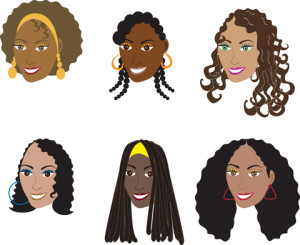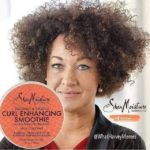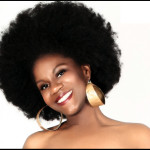So the Gabby-Hair-Drama continues. If you have no idea what the words “Gabby-Hair-Drama” mean, you can get a cliff notes version in Part 1 of this post.
Initially many had concerns that the longer this topic was in the spotlight the more harm it would cause. But as an “eternal optimist” – I actually think the conversation has begun to evolve into a more critical and powerful conversation among Black women about how we see ourselves.
Yes, I’m aware that this also means that non-Black people are talking about this too. However, at a certain point – silence is simply deadly. Other folk are going to talk about Sistas whether we are talking about ourselves or not. It’s been this way since Sarah Baartman was paraded about and won’t likely end any time soon.
But we can’t allow the voices of Others to keep us from claiming our Own voice, words and analysis. As we learned from the doll test – our very emotional lives depend on us finding a way to heal from the on-going trauma of racist oppression.
Why Self-Love?
When you don’t understand the ways that racism shaped how the Black community was taught to think and feel about our hair/lips/noses/beauty then you probably don’t know as much about Black hair as you thought you did.
Slavery and racism didn’t just turn White people into white supremacists. It essentially created a cultural value system that turned all of us – Whites, Blacks and everyone in between – into a nation that collectively values Whiteness above all else.
We are now all presumptively white supremacists.
And when you are a Black white supremacist, learning to despise your nappy hair is as natural as learning to breathe. Learning to love yourself becomes an extreme challenge. This is the nature of internalized racism.
One thing I learned early on in my natural hair journey is that that I was full of internalized racism. It was sort of like an addiction.
Different Types of Racism
Now before you get your napps in a kink, let me explain what I mean. As far as I can tell, there are three general forms of racism.
- Proactive Racist (i.e. race hater): this is who we typically think of when we think about racists. This person could be the stereotypical card carrying member of the Klan or some similar hate group. This is someone who despises people of another race and who works on an individual and/or collective basis to perpetuate that hate amongst others.
- Institutional Racism (or Systematic Racism): is the type of racism that, covertly or overtly, resides within the culture, policies, procedures and operations of institutions. It creates and maintains systems that re-direct the distribution of resources, power and opportunity to the benefit of White people and to the exclusion of Blacks and minorities.
- Internal Racism: this person may not believe in being racist, but they do believe that certain races are…well, just better (superior) than others. Conversely, they also believe that some races are not as good (inferior) as others. This type of racism can be self directed – which means that Black people who have not unlearned this form of racism participate in self-hatred.
When I talk about internal racism or Black white supremacists, I’m talking about definition #3 – people who for whatever reason – believe that there is something just sort of wrong with Blackness and Black features.
Like the Black girl who thinks her hair texture is inherently ugly. Like the Black person who refuses to date another Black person because they “can’t” find any “pretty” ones.
As eloquently stated by Esther Armah, over at Ebony.com,
Black beauty is more than facial features; it is a complicated, precious, powerful living history that includes intimate connections with violence—and is tangled with stories of rejection, privilege, love and lack, favor and hatred. Black beauty’s mirror has never just been our individual reflection staring back at us, it has been a history of a relationship with nations all over the world, their lens on our features and bodies, their opinion, their version of our beauty, how that version has changed and stayed the same over time–the mirror is our intimate revolution.
That paragraph basically sums up where we are today when it comes to our hair and sense of cultural self-esteem.
The Danger of Other People’s Eyes
We were forced to evaluate our hair and concept of beauty through the eyes of Others. But when evaluating yourself through someone else’s eyes, it is very important to understand how those eyes were trained to view you.
If those Other eyes see ugliness when they see you, if they see nappy-headed, inferior women when they see you, if they see someone to be despised when they see you, then what will you see as you look through their eyes and see yourself?
If the root (pun intended) of the problem is in our learned self-hate – then the cure must be in learning how to truly love who we are, as we are.
But how do you unlearn self-hate? Well, as Albert Einstein once stated:
The significant problems we face cannot be solved at the same level of thinking we were at when we created them.
So Black folks did not create self-hatred – but we are the only ones who can heal ourselves from it.
Step 1: Read.
After I discovered my own internal racism – I knew I had some work to do. I started by reading. A lot. I read any and everything I could about Black people and our experiences before, during and after slavery. I had to start there because everything I’d learned about the Black experience in school was either a lie or so incomplete that the truth was too hard to find.
I read books like The Mis-Education of the Negro, Chains and Images of Psychological Slavery and more. Since Black self-love is a never-ending job (because white supremacy is a 24/7 message machine) books like Post Traumatic Slave Syndrome and Brainwashed: Challenging the Myths of Black Inferiority help keep me focused.
The more I learned about the Black experience, the better I could understand why I felt the way I did about my hair and my people.
But the more I understood – the more angry I became.
Step 2: Allow the Anger, Then Grow Through It
Professor & author Tim Tyson once said, “Every psychologist will tell you that genuine healing [from trauma] requires a candid confrontation with one’s past. If there is to be reconciliation there must first be truth.”
I hate to say it – but a lot of us are afraid and/or ashamed of the anger we feel when we start learning about racism and how it shapes who we are today.
We shouldn’t be. I once heard that the anger of the oppressed is not a sign of sickness. It is a healthy sign of someone who recognizes that what is being done to them is wrong.
Just like the rape victim has to confront the brutality of what happened to her before she can heal, as Black women we too must confront and embrace our real history if we are going to learn how to truly love who we are and what we look like. That means allowing our selves to feel the anger and work through it so we can heal.
Step 3: Start Talking
Shame works best when kept secret. Self-hate is most powerful when we deny its existence. The work of healing how we feel about ourselves is serious business and cannot be done in isolation.
For instance – it was healthier for me to openly admit that I hated my hair and thought my nose was too big than it was for me to pretend like those feelings did not exist.
If you are “hair questioning” or searching for answers about hair and Black self-image, start talking to other like-minded women who had similar questions. If you’ve gone natural but are still battling the doubts that sneak in when someone stares at your twists too long – rush to your natural hair website of choice to reaffirm who you are and why you chose to embrace that person. If you need the support of Sista friends in your natural hair journey – start a mini-group of women who can meet regularly in order to build each other up.
Surround yourself with images that remind you of the beauty of Black womanhood on a daily basis. There was a time when I cut out every picture I could find of natural Black women in magazines. At that time there weren’t a lot to choose from – but I did my best. In a world hell-bent on telling me I was ugly, I needed constant reminders to keep the doubt away.
Step 4: This is a Journey – Not a Destination
Give yourself a break. Africa wasn’t colonized in a week and it’s highly likely that it will take a long time to be “free” of mental oppression. That’s ok. Last time I checked your Blackness wasn’t going anywhere so just sit back and enjoy the process.
As noted in the book 7 Habits of Highly Effective People,
To try and change outward attitudes and behaviors does very little good in the long run if we fail to examine the basic paradigms from which those attitudes and behaviors flow.
The only way for young girls like Gabby to be appreciated without the type of hair hate she received, is for the rest of us to start healing on the inside. Is this easy? Hell no. But we are worth the struggle. Our children are worth the effort. Our future is worth the sacrifice.
Let’s go ladies. Learning to love ourselves is serious business. We’ve got work to do.
Sound Off
Now I’m by no means an expert and this list of suggestions represents just four of the countless ways that Black women have made efforts to pro-actively love who they are. They worked for me and I hope they work for you. If you have additional suggestions for how Sistas can build up their cultural hair esteem – please share them in the comments. We can each get better when we all get better.





Hey, I just want to say that I love your site. Keep the info coming! I will be a daily reader!
“…the anger of the oppressed is not a sign of sickness. It is a healthy sign of someone who recognizes that what is being done to them is wrong.” So True!
Thank you for unpacking the process of moving past self loathing in a Euro-Supremacist society.
I stayed at steps one and two for years until I felt strong enough to get to step three. Step three has turned into a website where I explore the dimensions of healing our African American selves and becoming whole: http://riverglider.com